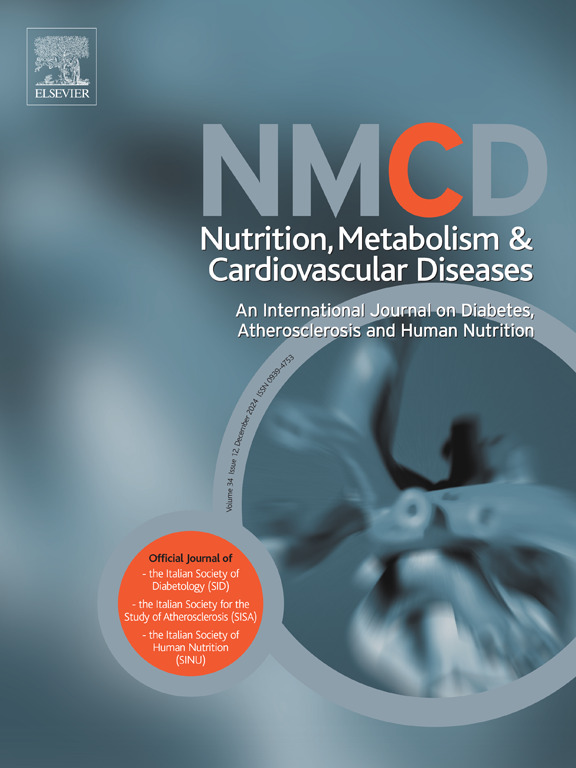代谢功能障碍相关脂肪肝、肝纤维化与心血管疾病风险:前瞻性队列研究。
IF 3.3
3区 医学
Q2 CARDIAC & CARDIOVASCULAR SYSTEMS
Nutrition Metabolism and Cardiovascular Diseases
Pub Date : 2024-09-12
DOI:10.1016/j.numecd.2024.09.001
引用次数: 0
摘要
背景和目的:在非酒精性脂肪肝患者中,肝纤维化会增加肝脏相关并发症,但对于心血管疾病的增加存在争议。本研究基于一项前瞻性队列研究,调查了代谢功能障碍相关性脂肪性肝病(MASLD)患者肝纤维化导致心血管疾病的风险:本研究分析了KCPS-II前瞻性队列,该队列追踪了2004年至2013年期间在全国18家机构参加健康体检的104399人。如果脂肪肝指数达到或超过 30,则被定义为 SLD,参与者被分为无 SLD、MASLD、MetALD、ALD 和隐源性 SLD。肝纤维化由 FIB-4 指数定义,心血管疾病的发生率则根据 SLD 分类采用 Cox 比例模型回归分析法进行分析。研究共纳入了6942名(6.6%)患有MASLD的参与者,6694名(6.4%)患有MetALD的参与者,4751名(4.6%)患有ALD的参与者,382名(0.3%)患有隐源性SLD的参与者。对于FIB-4指数≥1.3的病例,经多变量调整后,MASLD的心血管疾病HR(95% CI)为2.27(1.87-2-76),MetALD为1.67(1.30-2.10),ALD为2.56(1.99-3.30),而隐源性SLD为0.78(0.19-3.10),差异不显著。根据BARD划分的纤维化阶段得出的心血管疾病风险也呈现出相似的结果:这项前瞻性队列研究的对象是FIB-4≥1.3的新定义的MASLD、MetALD和ALD韩国患者,他们罹患心血管疾病的风险很高。本文章由计算机程序翻译,如有差异,请以英文原文为准。
Metabolic dysfunction-associated steatotic liver disease, liver fibrosis and risk of cardiovascular disease: A prospective cohort study
Background and aims
In patients with NAFLD, liver fibrosis increases liver-related complications, but there is controversy about the increase in CVD. Based on a prospective cohort study, this study investigated the risk of cardiovascular disease due to liver fibrosis in patients with metabolic dysfunction-associated steatotic liver disease (MASLD).
Methods and results
This study analyzed KCPS-II prospective cohort that tracked 104,399 people who participated in health check-ups at 18 institutions nationwide from 2004 to 2013. If the fatty liver index was 30 or higher, it was defined as SLD, and participants were classified into No-SLD, MASLD, MetALD, ALD, and Cryptogenic SLD. Liver fibrosis was defined by the FIB-4 index, and the occurrence of cardiovascular disease according to SLD classification was analyzed using Cox proportional model regression analysis. Out study included a total of 6,942 participants (6.6%) had MASLD, 6,694 (6.4%) had MetALD, 4,751 (4.6%) had ALD, and 382 (0.3%) had Cryptogenic SLD. For the cases of FIB-4 index ≥1.3, the multivariable-adjusted HR (95% CI) of cardiovascular disease was 2.27 (1.87-2–76) in MASLD, 1.67 (1.30–2.10) in MetALD, and 2.56 (1.99–3.30) in ALD, but it was 0.78 (0.19–3.10) in Cryptogenic_SLD, which was not significant. The risk of cardiovascular disease according to the fibrosis stage classified by BARD also presented similar results.
Conclusions
This prospective cohort study of Korean patients with newly defined MASLD, MetALD, and ALD with FIB-4 ≥ 1.3 at high risk of developing cardiovascular disease.
求助全文
通过发布文献求助,成功后即可免费获取论文全文。
去求助
来源期刊
CiteScore
6.80
自引率
2.60%
发文量
332
审稿时长
57 days
期刊介绍:
Nutrition, Metabolism & Cardiovascular Diseases is a forum designed to focus on the powerful interplay between nutritional and metabolic alterations, and cardiovascular disorders. It aims to be a highly qualified tool to help refine strategies against the nutrition-related epidemics of metabolic and cardiovascular diseases. By presenting original clinical and experimental findings, it introduces readers and authors into a rapidly developing area of clinical and preventive medicine, including also vascular biology. Of particular concern are the origins, the mechanisms and the means to prevent and control diabetes, atherosclerosis, hypertension, and other nutrition-related diseases.

 求助内容:
求助内容: 应助结果提醒方式:
应助结果提醒方式:


